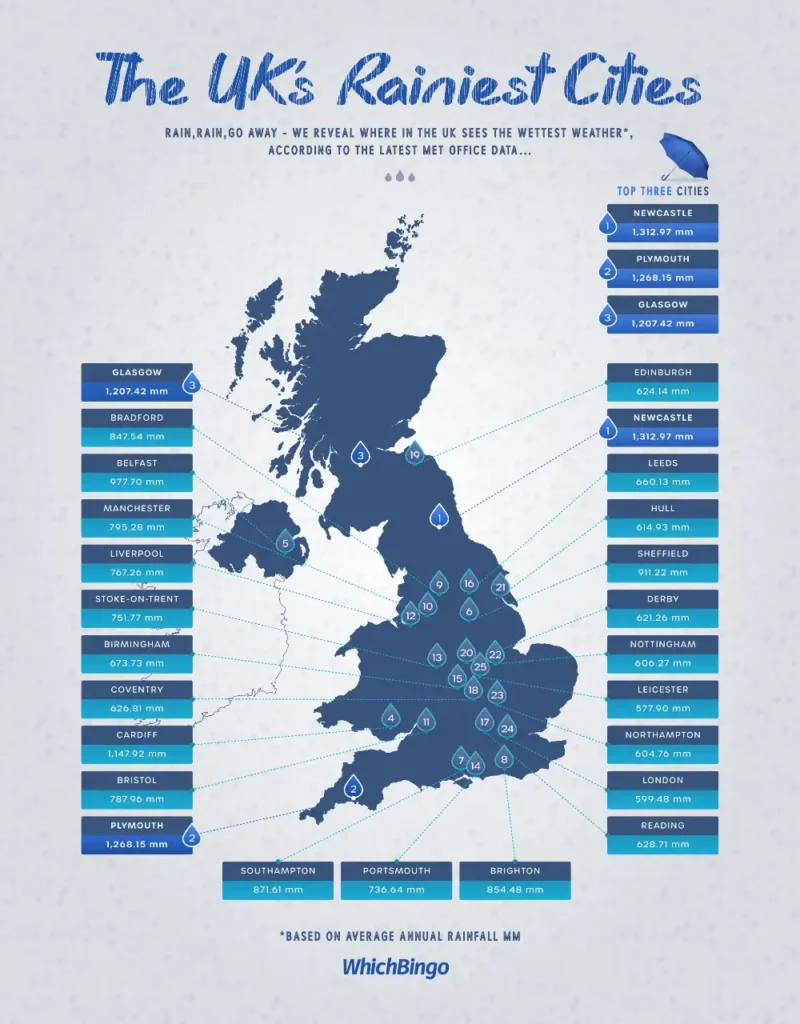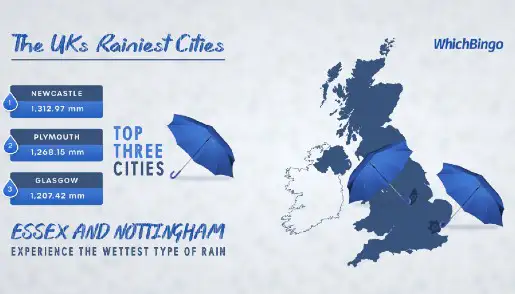Rain, rain, go away, come again some other day – but with the UK having a reputation as one of the wettest countries in Europe, how likely is it that we’ll see increased rainfall over the rest of the year now that summer is ending?
Speculation is rife as to what weather for the rest of the year will look like, given we reached a new UK record-high temperature of 40.3°C in July, following an unprecedented heat wave. The previous UK temperature record stood at 38.7°C, whilst this year also saw the driest July on record across southeast England. So, what does this mean for the nation’s rainy reputation?
The Wettest Regions Ranking from WhichBingo collates expert advice from Global Meteorologist Jim Dale, and data from the MET Office, to name the nation’s rainiest places – and debunk common misconceptions about rain.

Wettest Types of Rain
If you’re familiar with England’s dreary weather, you’ve probably heard the saying that the lightest rain actually soaks you more than heavy rainfall. But is there any truth to this, or is it an old wives tale? According to Jim Dale, Global Meteorologist and founder of the British Weather Services, no, as he says: “There is no argument, or at least there should not be. People will be soaked the most during the most intense rain, such as tropical intensity rain.” It turns out that the type of rain that’s most likely to get you drenched in the UK occurs during “high intensity summer thunderstorms”, although we haven’t seen many of those this year. So much for that rumour!
But at least different types of rainfall do result in different degrees of dampness, according to Dale, “there are at least 30 different types/intensities of rainfall, ranging from light intermittent drizzle to heavy violent rainfall. Frontal rain (long period) impacts the more western/northwestern regions of the UK, whilst sudden violent showers mainly impact southeastern areas. However, it should be noted that these anomalies can and do swap around.”
The Rainiest Regions
So, if there are different types of rain, where in the UK is subject to which type, and where is the soggiest part of the nation overall? Jim Dale had plenty to say on the matter, explaining that when it comes to where is most likely to experience the rain that gets us wettest (summer thunderstorms), it’s East Anglia, the South East (particularly Sussex, Essex and Kent), and the East Midlands. However, he says: “if we focus on long-period rainfall (i.e. where it is the wettest overall in the UK) then it’s Fort William in the shadow of Ben Nevis, and Capel Curig in the shadow of Snowden.”
On the other end of the scale, the driest areas of the UK “tend to be in South East England, starting with Cambridgeshire and moving into Norfolk and Suffolk. These areas tend to be heavily influenced by the nearby relatively dry European continent – and in common with other Southern areas of England – tend to experience greater instances of high pressure.” So it seems that the South East is prone to the most changeable weather, since some areas are the wettest, and some are the driest – making it hard to plan for local residents.
The study also looked at how MET Office data supports Jim Dale’s commentary, finding that of the UK’s major cities, those that experience the most annual rainfall and those that stay the driest, are as follows.
Major cities from most to least annual rainfall
| Ranking | UK City |
|---|---|
| 1 | Newcastle |
| 2 | Plymouth |
| 3 | Glasgow |
| 4 | Cardiff |
| 5 | Belfast |
| 6 | Sheffield |
| 7 | Southampton |
| 8 | Brighton |
| 9 | Bradford |
| 10 | Manchester |
Regardless of where it is wettest, Jim Dale also stresses the importance of preparing for extreme weather, as the nation is badly equipped to deal with high volumes of rain. He says: “The UK is not well-equipped to handle extreme rain, and particularly with global warming becoming more and more apparent. The UK is ‘tested’ every so often by serious flood potential rain, too often we fail either due to either the extreme nature of the rainfall, poor infrastructure, or a combination of both. The UK is not the worst-placed in handling such events when compared to third-world countries, but we have fallen behind in the past 10-12 years, largely due to government decisions and funding.”
A Rainy vs White Christmas
It seems that one notable impact of the warm weather this year is that there’s an increased likelihood of a drizzly festive period, as Jim Dale predicts that instead of a white Christmas, snow will come in “fits and starts, more likely in January through February.” Apparently, “dry summers can and often will lead to wetter autumn and winters,” so we may well end up swapping our sleds for umbrellas this time around.
So whether you end up frockling in the snow or are stuck inside to avoid the rain towards the end of this year, it’s clear that we’ll enjoy the festive period regardless – particularly after the ups and downs of the last year. To pass the time, why not take our top-rated new bingo sites for a spin.

Reader comments